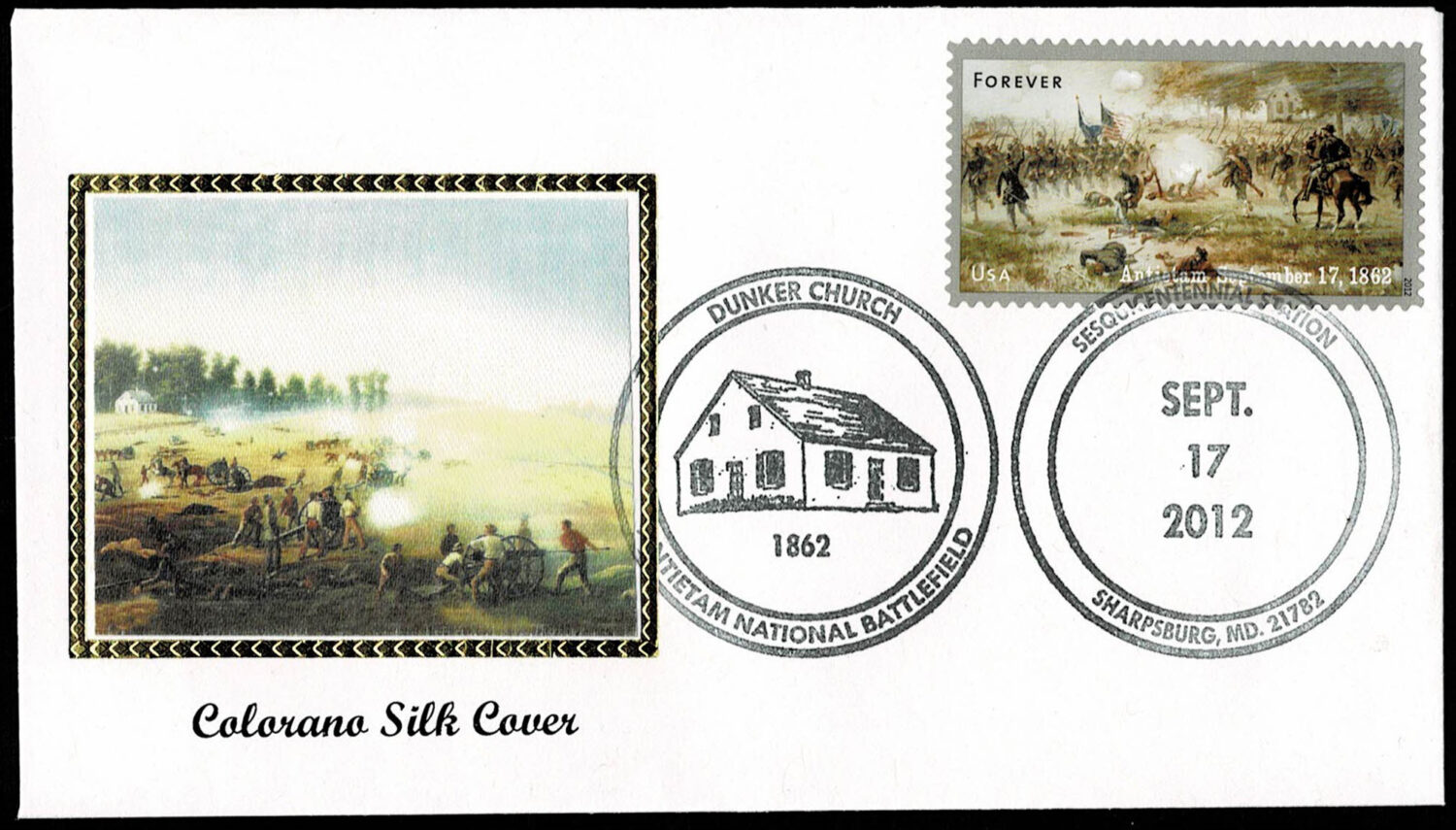
Maryland on Stamps…
Antietam,2012
Richard D. L. Fulton
Such a storm of balls I never conceived it possible for men to live through. Shot and shell shrieking and crashing, canister and bullets whistling and hissing most fiend-like through the air until you could almost see them…
– Lt. Col A.S. Pendleton, CSA
On April 24, 2012, the United States Postal Service issued a Forever Stamp commemorating the 150th Anniversary of the September 17, 1862, Battle of Antietam, which occurred among the fields and hills around Sharpsburg during the American Civil War.
The stamps were issued as part of a series of stamps commemorating the 150th anniversary of the 1861-1865 Civil War.
The Antietam stamp was issued along with the stamp commemorating the 1862 Battle of New Orleans. A sheet of stamps consisted of four Antietam and four New Orleans stamps (issuing different stamps attached to each other in a single sheet is referred to as se-tenant).
Antietam First Day of Issue covers can be found postmarked by the New Orleans Post Office (by virtue of being issued at the same time as the se-tenant New Orleans stamps) and by the Sharpsburg Post Office.
Confederate Maryland
Amid the secession of the Southern states as the nation stood on the brink of a civil war, a significant number of Marylanders had launched an effort to join the rapidly assimilating Confederate States of America.
It’s probably safe to state that the population of Maryland was deeply divided on the issue, with perhaps a third of the populace supporting the secession movement, a third rabidly against secession, and a third that wanted nothing whatsoever to do with either side, and simply desired to remain neutral.
Sensing the possibility that Maryland legislature might vote to join the Confederacy, President Abraham Lincoln dispatched agents into Maryland to track down and arrest any legislators who were found to be considering voting for secession.
In addition, the President sent federal troops to occupy Baltimore and Annapolis. Due to the federal occupation of the Maryland capital, the legislature was relocated to Frederick, resulting in Frederick having become the capitol of Maryland until the pro-secession legislators rescinded the effort to secede.
Although the secession effort failed, more than 20,000 Marylanders left the state and joined the Confederate Army.
The Road to Antietam
Confederate General Robert E. Lee, who commanded the Army of Northern Virginia, led his army north, beginning on September 4, 1862, ultimately colliding with the Union Army of the Potomac, commanded by General George B. McClellan, in and around Sharpsburg on September 17.
The Army of Northern Virginia consisted of more than 100,000 troops, while the Army of the Potomac consisted of some 50,000 troops (13,000 Union troops had already been captured in Harper’s Ferry two days before the engagement at Sharpsburg),
So why did Lee march into Maryland?
One of the primary reasons given was to take the war into the north in the hopes of convincing the Northern population of the futility of continuing the war. But another motive was inspired by the 20,000 Marylanders who had already joined the Confederate Army—that being the possibility that if the Confederates crossed into Maryland, countless additional Marylanders might have joined their numbers.
On September 17, the two opposing Armies collided around Sharpsburg, resulting in the bloodiest one-day battle of the “War of Rebellion.”
Before the September 18 withdrawal of the Confederate forces, the Confederates had suffered more than 28,000 casualties (of which 2,783 were killed), and the Union Army had sustained more than 16,000 casualties (of which more than 3,800 were killed).”
Although the battle ended Lee’s first invasion of the north, the outcome of the battle by most writers was/is considered as having been a tactical draw.
Some “historians” have claimed it was a Union victory, but Lincoln himself simply called the battle the “closest thing to a victory” that the Union Army had thus far experienced.
Lee also did not see any significant increase in Maryland recruits as having been a direct result of the Maryland campaign.

Sept. 12, 2012 Antietam First Day of Issue cover.
